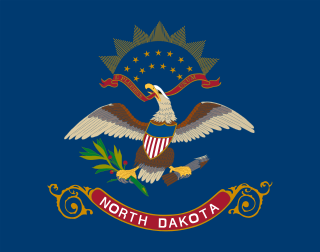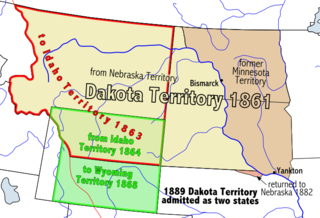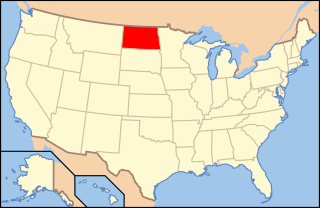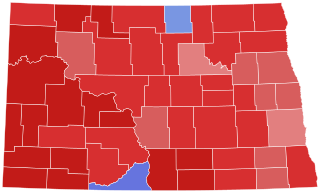
North Dakota is a landlocked U.S. state in the Upper Midwest, named after the indigenous Dakota Sioux. It is bordered by the Canadian provinces of Saskatchewan and Manitoba to the north and by the U.S. states of Minnesota to the east, South Dakota to the south, and Montana to the west. North Dakota is part of the Great Plains region, characterized by broad prairies, steppe, temperate savanna, badlands, and farmland. North Dakota is the 19th largest state, but with a population of less than 780,000, it is the 4th least populous and 4th most sparsely populated. The state capital is Bismarck while the most populous city is Fargo, which accounts for nearly a fifth of the state's population; both cities are among the fastest-growing in the U.S., although half of all residents live in rural areas.

The Territory of Dakota was an organized incorporated territory of the United States that existed from March 2, 1861, until November 2, 1889, when the final extent of the reduced territory was split and admitted to the Union as the states of North and South Dakota.

The North Dakota House of Representatives is the lower house of the North Dakota Legislative Assembly and is larger than the North Dakota Senate.

The North Dakota Senate is the upper house of the North Dakota Legislative Assembly, smaller than the North Dakota House of Representatives.

There are 459 properties and historic districts listed on the National Register of Historic Places in North Dakota. There are listings in 52 of North Dakota's 53 counties.
North Dakota was admitted to the Union on November 2, 1889.

The North Dakota Attorney General is the chief legal officer of the North Dakota state government. The Attorney General's State office represents the state government in court cases and issues opinions of points of law upon request. Drew Wrigley was appointed to the position on February 8, 2022, to finish the term of Wayne Stenehjem, who died in office.
The American Elm cultivar Ulmus americana 'Sheyenne' was raised by the Northwest Nursery Company of Valley City, North Dakota, before 1941, from a local elm in nearby Chautauqua Park.

The North Dakota secretary of state is an elected office in the U.S. state of North Dakota. The incumbent as of 2023 was Michael Howe. Duties of the secretary of state include being the custodian of the state's Great Seal and other official state documents, recording the official acts of the governor, distributing copies of legislative resolutions, and recording original bills and resolutions from each biennial Legislative Assembly. Other duties of the office include those pertaining to statewide elections, licensing within the state, and recording trademarks. The secretary of state is second in the line of succession to the office of Governor of North Dakota.

The following is an alphabetical list of articles related to the U.S. state of North Dakota.

The following outline is provided as an overview of and topical guide to the U.S. state of North Dakota:

The Lynch Quarry site, also known as the Lynch Knife River Flint Quarry, and designated by the Smithsonian trinomial 32DU526, is a historic pre-Columbian flint quarry located near Dunn Center, North Dakota, United States. The site was a major source of flint found at archaeological sites across North America, and it has been estimated that the material was mined there from 11,000 B.C. to A.D. 1600. The site was designated a National Historic Landmark in 2011.

The 2020 North Dakota gubernatorial election was held on November 3, 2020, to elect the Governor and Lieutenant Governor of North Dakota, concurrently with other federal and statewide elections, including the U.S. presidential election. Incumbent Republican Governor Doug Burgum and Lieutenant Governor Brent Sanford were both re-elected to a second term.